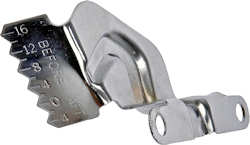Basic Ignition Timing
This data applies to a standard points-type ignition system. GM's HEI will follow the same basic routine. If you have an aftermarket units with a spark booster and/or electronic ignition system, you need to consult your information supplied by that manufacturer.
Ignition timing is a term applied to the relationship of piston travel and moment of spark in the engine. Due to many variables involved, such as compression ratio, humidity, elevations, fuel octane, engine condition, work load, etc. published timing data must be considered approximate with some tolerance permitted.
Ignition timing consists of basic and dynamic timing. It is important that point dwell be correct before timing an engine.
Basic Timing
Basic timing can be checked quite accurately with a timing light.
A timing light, when properly connected to the number 1 spark plug
wire and the battery. On a Chevrolet engine the crankshaft balancer
will have a 'timing mark' or groove. To better see this groove with
the timing light you might want to paint the groove white or bright
yellow to make it easier to see with the strobe from the timing
light. Typically there is a tab on the front engine cover with
several marks for degrees of advance like this aftermarket tab. Note
the '0' mark and several marking on the 'BEFORE' side of the '0' for
degrees of advance or 'before top dead center' (BTDC). Because
ignition timing is affected by the points setting the points need to
be set properly. See Timing Chain/Cam Gear Timing Marks/Harmonic Balancer
for setting cam and crank gears.

Click for larger image
![]() Unless otherwise stated by the distributor manufacturer, the
distributor control vacuum line should be disconnected, and plugged,
to prevent fuel induction disturbance. Loosen the distributor just
enough that you can move it with minimal effort.
Unless otherwise stated by the distributor manufacturer, the
distributor control vacuum line should be disconnected, and plugged,
to prevent fuel induction disturbance. Loosen the distributor just
enough that you can move it with minimal effort.
![]() Connect the timing light according to the manufacturer's
instructions.
Connect the timing light according to the manufacturer's
instructions.
![]() With the engine at operating temperature run the engine at low idle;
you can use a tachometer to adjust the engine speed. Many timing
lights have various functions built in such as a tachometer,
voltmeter, dwell angle measurement, etc.
With the engine at operating temperature run the engine at low idle;
you can use a tachometer to adjust the engine speed. Many timing
lights have various functions built in such as a tachometer,
voltmeter, dwell angle measurement, etc.
![]() Shine the timing light on the balancer mark and timing tab. Rotate
the distributor until the timing tab advance desired matches the
mark on the balancer. The mark on the balancer will appear to move
up or down under the timing lights' strobe light.
Shine the timing light on the balancer mark and timing tab. Rotate
the distributor until the timing tab advance desired matches the
mark on the balancer. The mark on the balancer will appear to move
up or down under the timing lights' strobe light.
![]() When the timing is set to the desired advance, carefully tighten the
distributor hold-down clamp then recheck to insure the timing hasn't
changed.
When the timing is set to the desired advance, carefully tighten the
distributor hold-down clamp then recheck to insure the timing hasn't
changed.
Dynamic Timing
To accurately check and calibrate dynamic timing through all attitudes of operation, a more sophisticated timing light is needed that can measure total timing at a high rpm. These timing lights can run from $75 for a basic digital unit to a little over $100. If you work on your cars a lot a good timing light is a good investment.
Vacuum Control
When timing an engine the vacuum hoe is disconnected from the distributor and plugged. You might want to check the tech article Timing 101 by GM and Chrysler Engineer John Hinckley on ignition timing.
Checking Vacuum Control
![]() Connect a timing light and tachometer as usual.
Connect a timing light and tachometer as usual.
![]() Connect a good vacuum gauge to the vacuum line between the
carburetor and distributor.
Connect a good vacuum gauge to the vacuum line between the
carburetor and distributor.
![]() With the engine at operating temperature and timing adjusted, run
the engine at low idle.
With the engine at operating temperature and timing adjusted, run
the engine at low idle.
![]() Shine the e timing light on the indexed area and observe the vacuum
reading and timing light index relationship.
Shine the e timing light on the indexed area and observe the vacuum
reading and timing light index relationship.
![]() Compare these readings with your engine's published vacuum advance
data.
Compare these readings with your engine's published vacuum advance
data.
![]() You also might want to take a look at the "How
to Read A Vacuum Gauge.'
You also might want to take a look at the "How
to Read A Vacuum Gauge.'
![]() Mention you saw it on © ChevelleWorld and please give the site credit for the
information.
Mention you saw it on © ChevelleWorld and please give the site credit for the
information.
![]() Be sure to visit my ChevelleCD site for
Chevelle CDs, challenge coins, and other gifts for that Chevelle fan in your
family and my
Stickers & Calendars website for custom stickers and calendars with your
favorite car/pet/occasion.
Be sure to visit my ChevelleCD site for
Chevelle CDs, challenge coins, and other gifts for that Chevelle fan in your
family and my
Stickers & Calendars website for custom stickers and calendars with your
favorite car/pet/occasion.

 1964 Chevelle
1964 Chevelle 1965 Chevelle
1965 Chevelle 1966 Chevelle
1966 Chevelle 1967 Chevelle
1967 Chevelle 1968 Chevelle
1968 Chevelle 1969 Chevelle
1969 Chevelle 1970 Chevelle
1970 Chevelle 1971 Chevelle
1971 Chevelle 1972 Chevelle
1972 Chevelle


